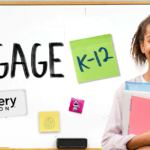By Jonathan A. Plucker (originally published in the April 2019 issue of AC&E)
The pursuit of educational equity and educational excellence are often seen as competing goals of our schools. I hear such rhetoric at school board meetings, it is implied in blog posts and tweets, and it frequently influences programs in our schools and classrooms. For example, one high-profile district adopted a policy a few years ago that forbade schools from offering algebra to Grade 8 students, under the guise that offering some students that opportunity was incompatible with the district’s equity goals.
Yet as I’ve visited schools around the world, I’m always struck by the different assumptions in other countries. Many do not treat equity and excellence as mutually exclusive, and in discussing this with my colleagues around the globe, I began to wonder how we can change the prevailing American mindset on these issues. How do we help people understand that we can provide equitable education outcomes and foster high levels of student achievement, and that such efforts can work hand-in-hand?
To help answer this question, my colleagues and I developed the concept of excellence gaps
Such gaps represent differences between groups of students at high levels of performance. Far fewer low-income students perform at high levels of achievement in every content area compared to higher-income students. As a case in point, on the 2017 NAEP math test for Grade 4 students, 3% of students receiving lunch assistance scored advanced, compared to 14% not receiving lunch aid.
Indeed, over the past quarter century, the growth in advanced achievement among higher-income students has sharply increased; advanced achievement rates for low-income students have stagnated. As a result, excellence gaps have grown considerably during this century.
Our team primarily focuses on excellence gaps as defined by family income and student race/ethnicity, but excellence gaps exist based on gender, ELL status, and locale (e.g., rural vs. suburban vs. urban students). In most cases, these excellence gaps have also grown considerably over the past couple decades, across all grades and content areas.
At the same time, the U.S. rates of advanced achievement compared to other countries are unimpressive. On the last round of TIMSS (Trends in International Math and Science Study) testing in 2015, 10% of U.S. Grade 8 students scored at the advanced level in math, a similar rate to students in the U.K. But 14% of students in Russia scored advanced, as did 34% in Japan, and over 40% in South Korea and Taiwan. We could examine results from other content areas and on PISA, the other major, international testing program, and the data would tell the same story: Low excellence rates for U.S. students compared to their peers in most developed and many developing countries.
This evidence – large excellence gaps coupled with low levels of advanced performance – suggest that our traditional, bifurcated approaches to equity and excellence are not working very well. But in talking to K-12 administrators and teachers, many are not aware that researchers have identified a range of promising interventions for closing excellence gaps and helping more students become high achievers. The purpose of this series of articles is to share information on specific interventions that hold promise for raising more students to advanced levels of learning and shrinking excellence gaps. Our focus will be primarily on research-based interventions that districts around the country are using effectively, but we will also profile districts that are learning valuable lessons are they try new approaches to equitable talent development.
One quick note on terminology:
People often ask me if I’m talking about gifted education when I talk about academic excellence. I’m not not talking about, but this discussion is much broader than traditional gifted education. We need to adopt a mindset that large numbers of our students are capable of achieving at high levels – and probably much higher numbers than most of us traditionally expect. Gifted education certainly plays a role in addressing these issues, but the goal here is to help educators create systems of advanced teaching in order to promote advanced learning.
I am excited to share excellence gap strategies with you in coming issues, and I look forward to your feedback.
Additional Resources
- Plucker, J. A., Hardesty, J., & Burroughs, N. (2013). Talent on the sidelines: Excellence gaps and America’s persistent talent underclass. Storrs, CT: University of Connecticut, Center for Education Policy Analysis. Retrieved from http://cepa.uconn.edu/mindthegap.
- Plucker, J. A., & Peters, S. J. (2016). Excellence gaps in education: Expanding opportunities for talented youth. Cambridge, MA: Harvard Education Press.
- Plucker, J. A., Peters, S. J., & Schmalensee, S. (2017). Reducing excellence gaps: A research-based model. Gifted Child Today, 40, 245-250.
Jonathan A. Plucker is the Julian C. Stanley Professor of Talent Development at the Center for Talented Youth at Johns Hopkins University, where he is also a Professor of Education.
The American Consortium for Equity in Education, publisher of the "Equity & Access" journal, celebrates and connects the educators, associations, community partners and industry leaders who are working to solve problems and create a more equitable environment for historically underserved pre K-12 students throughout the United States.
- American Consortium for Equity in Educationhttps://ace-ed.org/author/admin/
- American Consortium for Equity in Educationhttps://ace-ed.org/author/admin/April 23, 2025
- American Consortium for Equity in Educationhttps://ace-ed.org/author/admin/
- American Consortium for Equity in Educationhttps://ace-ed.org/author/admin/







